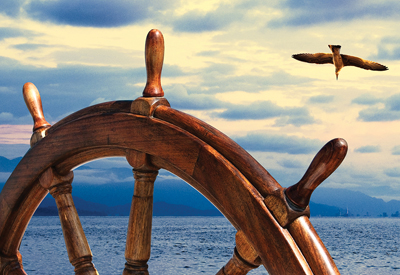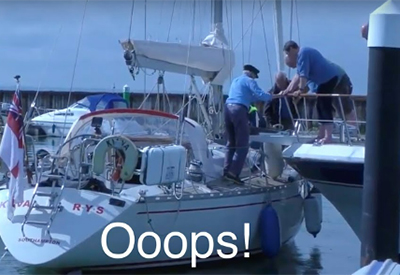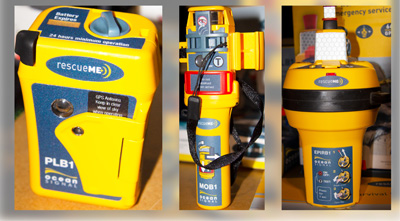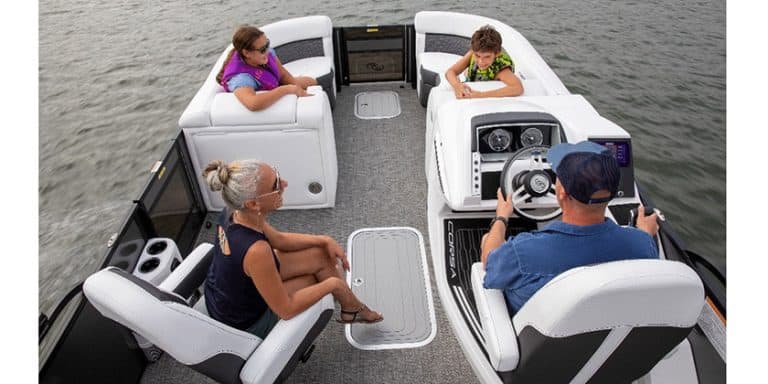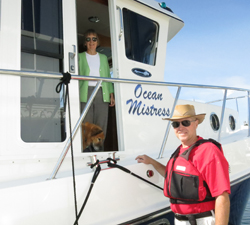Falling for Fall – Fall Cruising Tips

Summer may be fleeting but the rewards of autumn cruising include a slower pace, quieter destinations, surprisingly good weather, and maybe even a few thrills.
The full moon rose big and bright, its track shimmering across the water into our anchorage near the head of Salt Spring Island’s Long Harbour. Golden lights winked on one by one in the cottages around the bay, reminding me that I wasn’t completely alone.
After a precious sunny, almost-warm late-autumn day, it was one of the most beautiful evenings I’ve ever spent on the hook. It was also one of the coldest, for we had yet to install a heater in our 27’ sailboat Squid. Early dusk meant plummeting temperatures, so I piled on every piece of clothing I had, took comfort from the warmth of the homey lights around me, ate an early dinner and buried myself in my sleeping bag.
That winter, I added a bulkhead heater to our trusty sailboat.
Tip# 1: Safe, reliable heat is essential to enjoying early or late-season cruising. Choose a heating system that suits the size and systems of your boat and ensure it is installed and operates safely. No unventilated portable heaters on the cabin floor!
We have always done much of our cruising in late summer and early fall, enjoying the slower pace, solitude and surprisingly good weather in destinations such as the Gulf Islands, the San Juans and Desolation Sound. Balmy late-summer weather often continues well into September, long after the crowds have gone home. Anchorages and marinas are usually quiet on all but the warmest autumn weekends, and pretty much empty on weekdays.
Coastal weather does become unsettled as summer fades but if you’re prepared for the challenges of fall boating, you may enjoy some of your most memorable days on the water and experience familiar destinations in an entirely a new way.
If you’re new to fall cruising, this article is intended to nudge you out there, prepared to stay safe and enjoy the season’s slower pace and subtle rewards.
Tip #2: Prepare your boat and crew. You’re more likely to be on your own, so be ready to be self-reliant. Check systems such as engines, fuel filters, heating, rigging and so on before you leave the dock – and learn how to make at least minor repairs to keep you going. Dress for varied temperatures and weather, including rain.
Weather is the key to your safety and comfort when you cruise in the fall. In late summer, the stable high-pressure system that tends to park off the West Coast and bring the seemingly endless dry days of August gives way to the parade of lows and highs that produces wet, unsettled and unpredictable autumn weather. This can be a good thing and a bad thing.
For sailors, these big, fast-moving weather systems deliver some of the best breezes of the season. This is the time to truly enjoy cruising under sail, often well-reefed! Breaks between systems also bring periods of excellent weather, to be enjoyed by the alert, flexible cruiser.
But colliding ridges and troughs can also produce rough, potentially dangerous wind and sea conditions that impact passage-planning and choice of anchorages, and can make an ill-timed boat trip memorable for all the wrong reasons. For powerboaters, choosing windows carefully for crossing open water can make the difference between fun and fear, comfort and chaos. The same is true of choosing a spot to drop the hook for the night, or even a marina to escape the worst.
I approach weather in the fall just as I do all summer – only more so. For several days before a passage or cruise, I monitor Environment Canada’s marine forecasts on its website (www.weatheroffice.gc.ca) to get a feel for current patterns before I decide to stay or go. On the water, I listen to continuous marine broadcasts on VHF several times a day; in unsettled weather forecasts can change from one scheduled update to the next, or even warrant weather warnings, so don’t assume the morning’s forecast is good enough.
Watch your barometer for changes in pressure. Stable is good, rapid movement up or down is not. Watch the sky – if you’ve spent much time on the water you probably have a better feel than you think for what cloud movements and changes in wind strength and direction can tell you about coming conditions. Fast-moving clouds or unusual formations deserve your attention.
Tip #3: Pay closer attention to the weather than you normally would. Use all the tools at your disposal to find out what’s coming: the Internet, marine broadcasts, barometer, observation, even calling ahead to your destination.
Next, match what you expect from the weather to the capabilities of your vessel and your cruising plans. A slow trawler like our GB 32 needs a window of three to five hours to cross the Strait of Georgia, while a fast planing or semi-displacement powerboat may need half that time or less. In a sailboat, sailing angle is crucial: a reach is a lot faster and more comfortable than a beat.
Be flexible – wind or weather may allow you to leave the dock as long as you head for a different destination than originally planned. If the weather changes while you’re out cruising, think twice before racing home or proceeding on a tight schedule. If you’re safe and comfortable where you are, stay there until the weather improves. Above all, have a Plan B and a Plan C so you’re ready if conditions change faster than you expected.
Tip #4: Match the forecast to your vessel’s capability and your cruising plans – choose weather windows for crossing open water with care. Make Plans B and C just in case.
A real pleasure of fall cruising is how quiet even our most popular anchorages and marine parks can be. This is partly because unsettled weather keeps less intrepid boaters at home. But it’s also because some anchorages that draw crowds in summer become uncomfortable or untenable when the weather turns rough.
On the October night mentioned above, I chose Long Harbour as a refuge from forecast strong northwesterly winds. Sheltered by bluffs, I enjoyed a quiet night while the breeze blustered down Trincomali Channel, and across the channel Montague Harbour was probably very uncomfortable. In the Gulf Islands, poor shelter or poor holding may make spots like Montague, Sidney Spit, Portland Island, Wallace Island’s Princess Cove, Pirates Cove, even Ganges Harbour less than ideal anchorages in strong winds or unsettled weather. Look elsewhere for good shelter from north or south, depending on the forecast, and reliable holding. In Howe Sound, southerly inflow winds that blow routinely on summer days may be non-existent, but strong northerly outflows will dictate your choice of anchorages. Or head for a friendly marina, where you’ll find a sturdy dock, possibly off-season rates and, if you’re lucky, a warm pub and a pint.
Tip #5: Choose anchorages carefully for shelter and reliable holding. Spots that are popular in settled summer conditions may not be comfortable or safe in the autumn. Or consider a marina.
In autumn, our islands and waters return to their rightful inhabitants, the wildlife. If you enjoy the natural world, places like the Gulf Islands can be exciting places as summer fades. Migratory birds stop or winter here, while year-round residents re-emerge when the crowds disappear. You may see loons, grebes, oystercatchers, murrelets, guillemots, herons, geese, eagles and other species here in profusion. Shoreside denizens such as otter and mink become less shy. You may enjoy surprise sightings of whales or porpoises. Pull on a sweater or fleece, grab the binoculars and settle down to be entertained.
Tip #6: Bird and animal life abounds on the coast in fall and winter. Enjoy the show.
We attended our first Grand Banks rendezvous last September at Thetis Island’s Telegraph Harbour, and the weekend typified fall cruising from start to finish. The weekend forecast sounded dire but Friday looked fine so we crossed comfortably from the North Arm to Gabriola Pass. However, it was clear that getting home again was going be a challenge.
Weather systems rolled around us while we partied in sunshine on Saturday – we heard about toppling trees and cancelled ferries in the Lower Mainland. On Sunday morning, worried skippers compared notes. A few boats returned to Sidney through sheltered waters, and one or two large vessels braved the strait, but most crews opted to stay on the dock.
We needed to return to Vancouver by Tuesday but Monday sounded worse yet, so we opted for Plan B. We would join a couple of Nanaimo boats in a flotilla north through Dodd Narrows, leave Thea on the Nanaimo Harbour dock, and ferry home that evening. So off we went.
While Jan steered north, I opened the aft cabin door for a look behind us. Under an ominous grey-purple sky, whitecaps whipped by 25 knots of wind chased us up Stuart Channel and rain squalls obscured the Vancouver Island shore. But we were safe and comfortable. And it occurred to me how exhilarating this afternoon was, how exciting it was to be alive and on the water, how reassuring our boat felt in the conditions. Summer cruising isn’t like this…
Three days later I collected Thea with a hardcore sailing friend who would have been up for a little excitement…and we chugged home across a sunny, windless strait.
That’s fall cruising.
Tip #7: Done safely, fall cruising offers thrills and spills that can be hard to find on lazy summer days. You just might get hooked…
Story & Photos by Duart Snow


